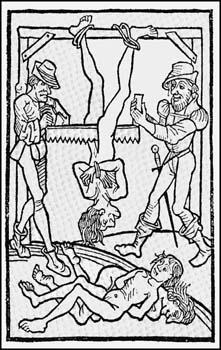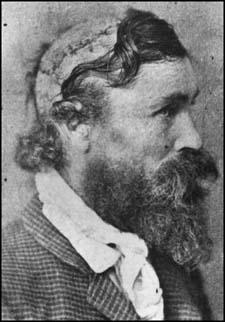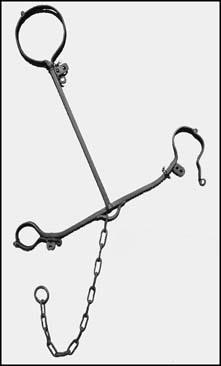Read The Big Book of Pain: Torture & Punishment Through History Online
Authors: Daniel Diehl
The Big Book of Pain: Torture & Punishment Through History (38 page)

Pincers at work.
PRICKING
Invented as a means of determining whether or not a woman was a witch, pricking involved jabbing the victim with an iron needle mounted on the end of a wooden handle.
According to the theory of the day, a witch had places on his or her body, properly known as
stigmata sagarum
, which, thanks to the intervention of the Devil, were impervious to pain. In practice, everyone has small places where there are few nerve endings, particularly on the back. Alternately, when a victim has been jabbed often enough, the nervous system will simply shut down. Some witch hunters, notably the notorious Matthew Hopkins, the self-styled Witchfinder General of England, carried a witch-prick with a retractable needle. When the device was pressed against the victim’s flesh, the needle retracted into the handle, making it appear as though they had been jabbed, but with so slight a pressure that it often went unnoticed.

Skewers for pricking.
SAW
There is really very little that can be said about this method of torture which is not abundantly clear in the accompanying images. Obviously this is a form of execution, but it is one that would be slow and painful. It should be noted, however, that in the images where the victim is suspended upside-down and the torturers/executioners begin cutting them in half at the groin, the victim (owning to the fact that the brain is maintained with a supply of blood and oxygen) will remain alive throughout the horrific ordeal until the saw reaches the heart or lungs.

Sawing.

Aftermath of a scalping.
SCALPING
Although it may extend back into the mists of history, the practice of scalping is first recorded in the annals of that doughty Viking king of southern England, Canute (reigned 995–1035). Centuries later, the practice was revived by the French – who were busily trying to wipe out every English settlement in the New World – and explained the practice to their American Indian mercenary forces as a means of proving how many English men and women they had killed. The Indians were paid on a per-head basis and scalps were much easier to transport than complete heads. It should be noted that scalping, itself, is not necessarily fatal. A scalping victim may live, but the exposed top of their skull will forever be exposed to the air and will need constant applications of oil to keep the skull bone from drying out.
ANCHOR
This cruel instrument of restraint forced the prisoner into a humiliating posture of submission. The use of this device for prolonged periods in damp dungeons would sometimes result in permanent deformity of the spine. Different models of this device can be found in the chamber of torture at the Castle of Kwidzin in eastern Poland.
BILBOES
Much like the hobbles used to keep horses from wandering, the bilboes were nothing more than two ankle shackles set at opposite ends of an 18in-long iron bar. Apparently deriving their name from Bilbao, Spain, where they were reputedly invented, the bilboes could either be used to keep prisoners from running away or, by the addition of a chain, secure the victim to a post, a wall, or any other permanent fixture.

Bilboes.
BINDING
One of the surest, quickest and cheapest methods of making a person suffer is to immobilise them with rope restraints. The tighter the victim is bound, the greater their suffering. This rather obvious fact has undoubtedly been recognised throughout history and in every geographic location on the globe, but some people seemed to excel at the art of binding with the express purpose of inflicting the greatest possible amount of pain. In India prisoners were bound in impossibly unnatural positions, such as having one leg tied to their opposite shoulder and pulled as tightly as possible or by placing a noose around their throat, the other end of which was pulled down his back and tied to his ankles; any attempt to move would nearly strangle him.
From Henry VIII’s England comes the case of Mark Smeaton, the court minstrel who was accused of dallying with Queen Anne Boleyn. To induce a confession, Smeaton’s head was encircled with a knotted rope, the knots being arranged so they rested over his eyes. When the rope was twisted tight the pressure compressed Smeaton’s eyes until they exploded. On a smaller scale, the Spanish Inquisition often bound a victim’s thumbs together with a small cord which was wrapped so tightly that blood spurted from beneath the thumbnails. The Inquisition were masters of the rope and more of their inventive rope-based tortures are described below.

The anchor.
GARROTTE
Death by strangulation has always been around but in medieval Spain the practice became a standard means of execution for criminals of all sorts. The
Garrotte
, the official mechanism employed in Spanish judicial strangulation, took the form of a small stool attached to a short post. The victim was bound hand and foot and seated on the stool before a metal collar, which was attached to the post, was fixed around their neck. At the back of the collar was a crank, or screw which, when turned, drew the collar tighter and tighter until the victim’s neck was slowly pulled onto a metal spike which protruded from the post. In theory, the spike punctured the cervical vertebrae, killing the victim in seconds; in practice the victim was usually strangled to death.
IRON COLLAR
Iron collars, attached to the end of a length of chain which was, in turn, attached to a ring mounted into the wall of a dungeon or prison cell, have been a favourite form of restraint since the invention of iron. They kept prisoners firmly in their place and could be used to haul them around as the need arose. Occasionally the victim was kept a bit too firmly in place. In Carlisle Castle, in the north of England, the chain from collar to wall was so short that if the prisoner happened to roll out of bed they were almost sure to strangle themselves. A popular variation on the collar was the ‘jaggs’, known in Holland as ‘
joungs
’ and in France as the ‘
Carcan
’. The collar was the same as always, but rather than being mounted in a cell it was attached to a church wall or the local market cross, thus allowing religious transgressors to be exposed to public humiliation while they contemplated their sinful life.
LITTLE EASE
Although not technically a restraint, Little Ease was a notoriously small cell in the Tower of London. So tiny was Little Ease that a prisoner shoved inside had no room to either stand up or lie down, being forced into a perpetual crouching position. Although Little Ease is the best documented place of tight confinement, one can assume that many such hell-holes existed in the Middle Ages and well into the eighteenth or nineteenth century.
PORTO
Yet another of the Spanish Inquisition’s notorious rope tortures, the
porto
consisted of a rack-like wooden bed in which a series of holes had been drilled at strategic locations. When the victim was laid out on the bed, ropes were threaded through holes located on either side of both arms and either side of his thighs. With the help of a windlass, the ropes were pulled so tight that they dug through flesh and muscle tissue, often tearing their way to the bone. One variation on the
porto
was to have the ropes attached to the wall rather than to a wooden bed. The prisoner was seated on a small stool, the ropes threaded through wall-mounted iron rings, conveniently located at the hands, arms and waist. When the ropes were pulled tight enough the stool was kicked away and the prisoner dangled from the wall until he was ready to cooperate.

